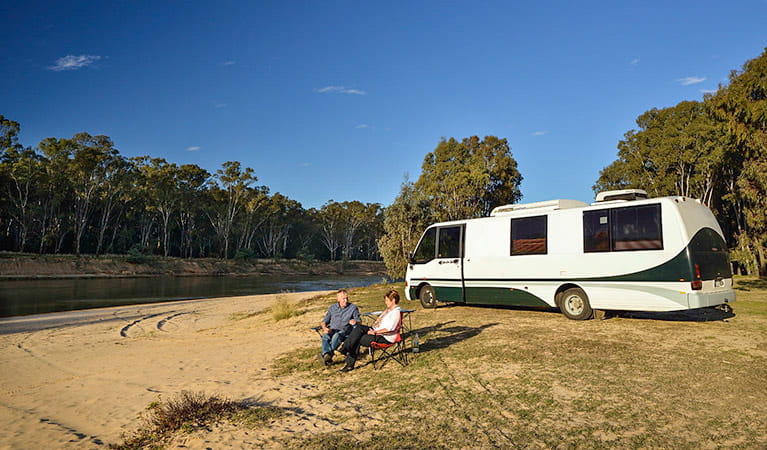Quicks Beach campground
Murray Valley National Park
Overview
Spend the night right next to the Murray River at either Quicks Beach or Kerrs Beach campground. A perfect spot to set up your tent, caravan or motorhome and enjoy the sandy beaches.
| Camping type | Tent, Camper trailer site, Caravan site, Camping beside my vehicle |
|---|---|
| Facilities | Toilets |
| What to bring | Drinking water, cooking water |
| Price | There are no camping fees at this campground but a $6 booking fee applies. |
| Group bookings | Bookings for up to 9 sites and 40 people can be made online. School groups and commercial tour operators can submit a group booking enquiry form. |
| Please note |
|
With the Murray River at your front door, and the magnificent river red gums in your backyard, Quicks Beach and Kerrs Beach campgrounds are only 3.5km from the centre of Barooga. There are plenty of sites for caravans, camper trailers, motorhomes and tents at each of these campgrounds, with toilet facilities located close to Quicks Beach.
Take your fishing gear and your swimmers – the river is perfect for dropping in a line and the grassy campground rolls down to a sandy beach where the kids can build a sandcastle or two. It’s also a good spot for some paddling.
Map
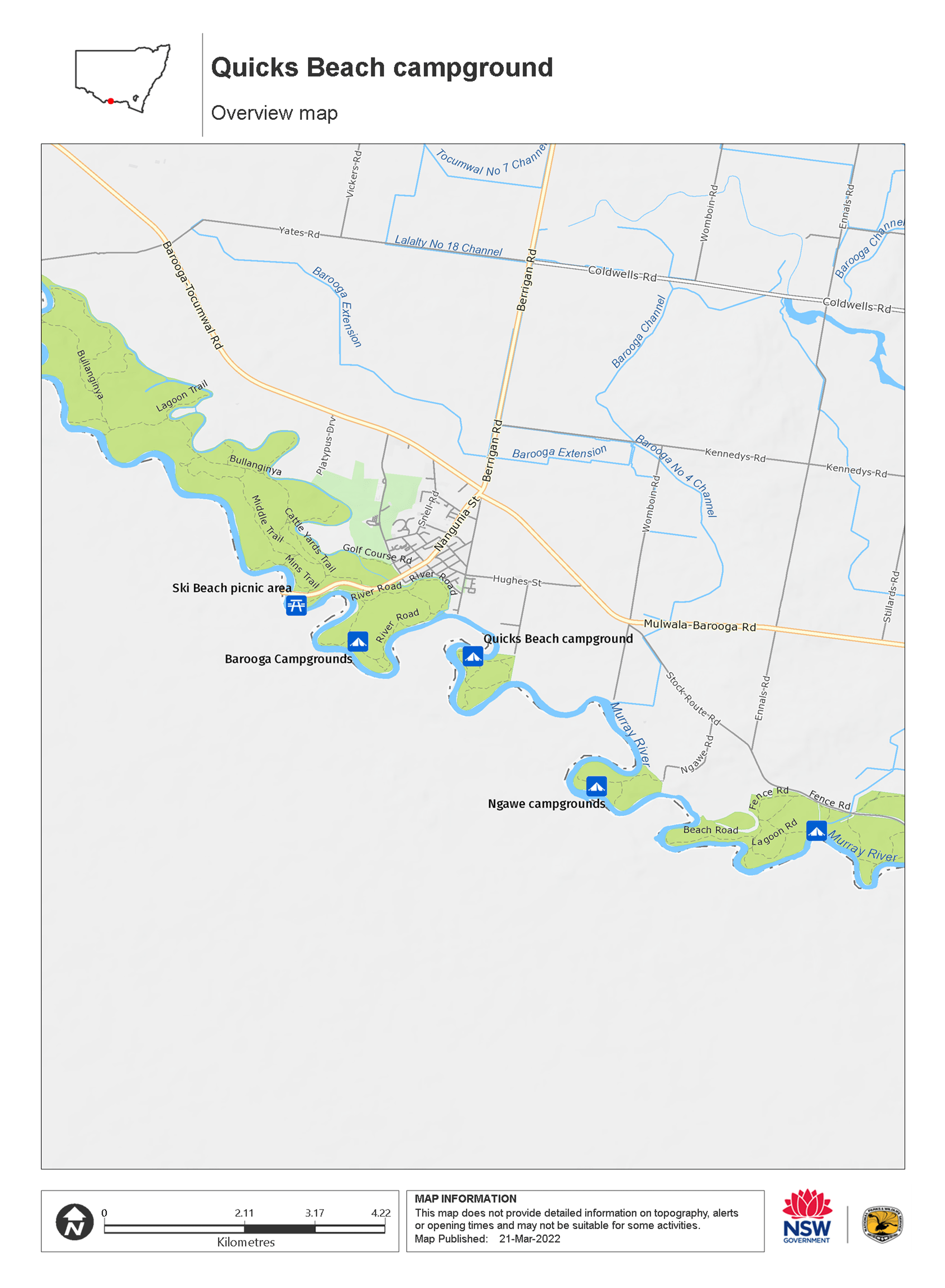
Map legend

Local alerts
For the latest updates on fires, closures and other alerts in this area, see https://www.nationalparks.nsw.gov.au/camping-and-accommodation/campgrounds/quicks-beach-campground/local-alerts
Bookings
- National Parks Contact Centre
- 7am to 7pm daily
- 1300 072 757 (13000 PARKS) for the cost of a local call within Australia excluding mobiles
- parks.info@environment.nsw.gov.au
Operated by
- Moama office
- Monday to Friday, 9am to 4pm. Closed 12pm to 1pm.
- 03 5483 9100
- npws.riverina@environment.nsw.gov.au
- Factory 5, Lot 8 Bowlan Road, Moama NSW 2731
Park info
- in Murray Valley National Park in the Murray-Riverina region
Murray Valley National Park is always open but may have to close at times due to poor weather or fire danger.
Visitor info
All the practical information you need to know about Quicks Beach campground.
Getting there and parking
Quicks Beach is in the Cottadidda precinct of Murray Valley National Park.
If you’re travelling from the south, travel to Cobram and then Barooga:
- Cross the bridge over the Murray River, and travel 2.5km along Vermont Street
- Turn right into Hughes Street and then right onto Quicks Road
- Follow the track towards the river bank, it's about 300m to the campground
To get there from the north, travel to Barooga town centre:
- Turn left into Hughes Street about 2.5km before the bridge
- Turn right onto Quicks Road and into the park
- Follow the track towards the river bank it's about 300m to the campground
Road quality
Check the weather before you set out as the road to Quicks Beach can become boggy when it rains.
- Unsealed roads
Vehicle access
- 2WD vehicles
Weather restrictions
- Dry weather only
Parking
Parking is available at Quicks Beach
Best times to visit
There are lots of great things waiting for you in Murray Valley National Park. Here are some of the highlights.
Autumn
The perfect time for a camping holiday: the days are cooler and the nights are not yet too chilly.
Spring
If it's been a wet winter white ibis and straw necked ibis will be nesting from late winter through to spring.
Summer
A great time for water activities on the Murray - swimming in the river is a delightful way to spend your time.
Winter
The morning light sparkles on the river; try your hand at fishing for Murray cray.
Weather, temperature and rainfall
Summer temperature
Average
12°C and 32°C
Highest recorded
44.7°C
Winter temperature
Average
3°C and 17°C
Lowest recorded
–3.8°C
Rainfall
Wettest month
August to October
Driest month
February
The area’s highest recorded rainfall in one day
98mm
Facilities
Water is not available at this campground.
Toilets
- Non-flush toilets
Maps and downloads
Accessibility
Disability access level - hard
- Wheelchairs can access this area with some difficulty
- Toilet facilities are wheelchair accessible
Permitted
Fishing
A current NSW recreational fishing licence is required when fishing in all waters.
Prohibited
Pets
Pets and domestic animals (other than certified assistance animals) are not permitted. Find out which regional parks allow dog walking and see the pets in parks policy for more information.
Smoking
NSW national parks are no smoking areas.
Learn more
Quicks Beach campground is in Murray Valley National Park. Here are just some of the reasons why this park is special:
Aboriginal heritage
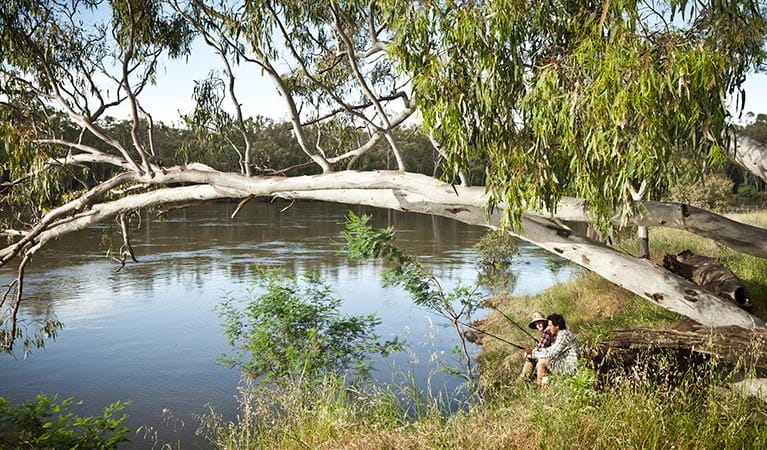
The river red gum forests of the Murray Valley are the traditional Country for Aboriginal people. The landscape and all that it contains; rivers, forests, birds and animals are part of cultural beliefs and feature in Dreaming stories. The park provided a wealth of resources, including plants that were used as medicines and in tool making. The river was a rich food source; in some seasons the water was so clear and the fish plentiful. When you're exploring the park, keep your eyes open for Aboriginal sites, especially middens, oven mounds and scarred trees, where bark has been removed from the tree to make canoes, coolamons and shields.
An abundance of treasures
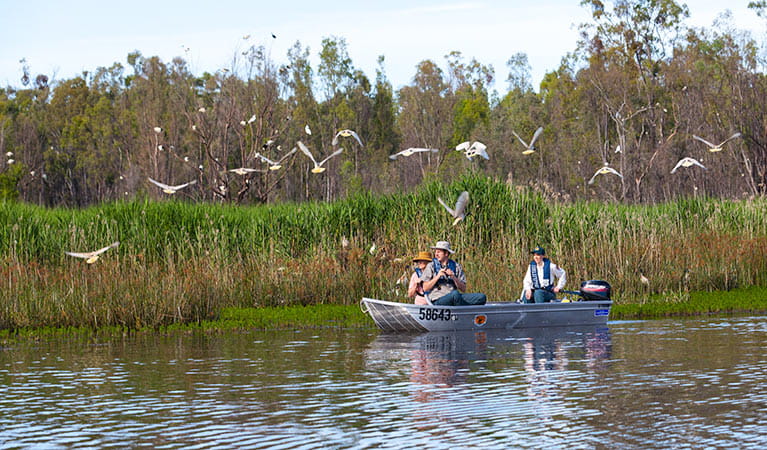
The Ramsar-listed Murray Valley wetland is home to over 60 threatened native animal species and 40 threatened plant species. Lay down the paddle of your canoe and sit in the silence, enjoying the company of egrets and cormorants, and keep an eye out for the superb parrot, slender and bright green. You may also see night herons, black swans, yellow rosellas, ducks, falcons, cockatoos, tree creepers, pardalotes, kingfishers and owls - this is truly a bird-lover's paradise.
- Moira Drive The scenic Moira drive takes you through the gorgeous river red gum forest around the mighty Murray River. Walk to the water bird observatory and stop for a picnic lunch.
- Murray River canoe trails These 4 canoe trails in Murray Valley National Park and Victoria’s Barmah National Park offer something for every paddler. Canoe the flowing Murray River, secluded creeks or Barmah Lake.
- Personalised birding tours around Deniliquin Keen birders will love these tailored outings by Australian Ornithological Services. They're a great way see rare and endemic birds, including plains wanderers, in the unique ecosystems near the outback town of Deniliquin.
- Reed Beds Bird Hide boardwalk It’s an easy walk along the boardwalk to Reed Beds Bird Hide, with fun things to do along the way. Listen to see how many different bird calls you can hear on the way.
Forestry history
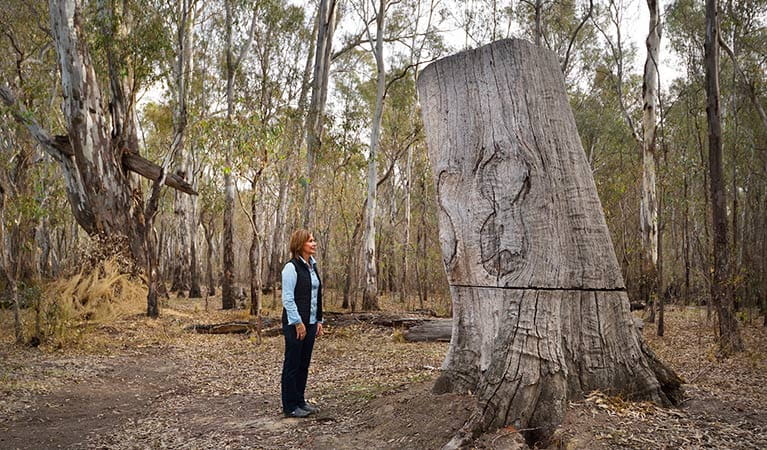
The magnificent river red gums have made this an important area for forestry and milling since the mid-nineteenth century. By the 1870's, construction of railway lines brought great demand for red gum sleepers; logging became a key feature of this area's industry. Wood-chopping events have long been a feature of local festivals and many people who live in Mathoura are third and fourth-generation timber workers.
River red gum country
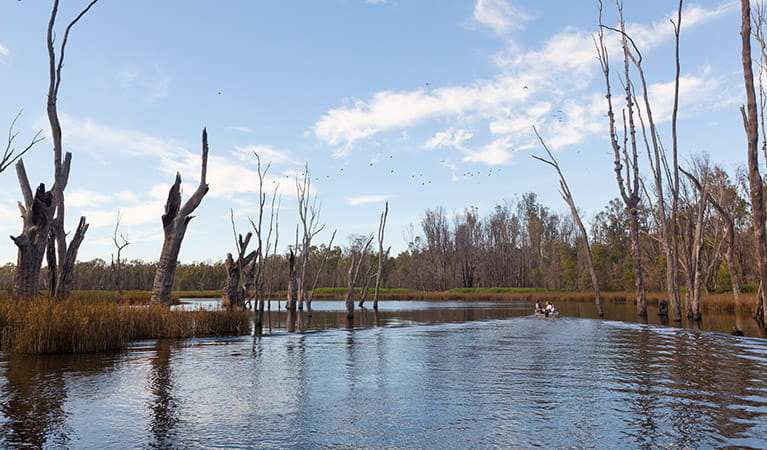
This iconic landscape features the huge river red gums soaring from the banks of the Murray and wetlands that make up this part of the Riverina's important ecosystem. This new park, formed from a number of former state forests, is part of the largest continuous river red gum forest in the southern hemisphere and is an important and unique ecosystem.
- Moira Drive The scenic Moira drive takes you through the gorgeous river red gum forest around the mighty Murray River. Walk to the water bird observatory and stop for a picnic lunch.
- Personalised birding tours around Deniliquin Keen birders will love these tailored outings by Australian Ornithological Services. They're a great way see rare and endemic birds, including plains wanderers, in the unique ecosystems near the outback town of Deniliquin.
Plants and animals protected in this park
Animals
-
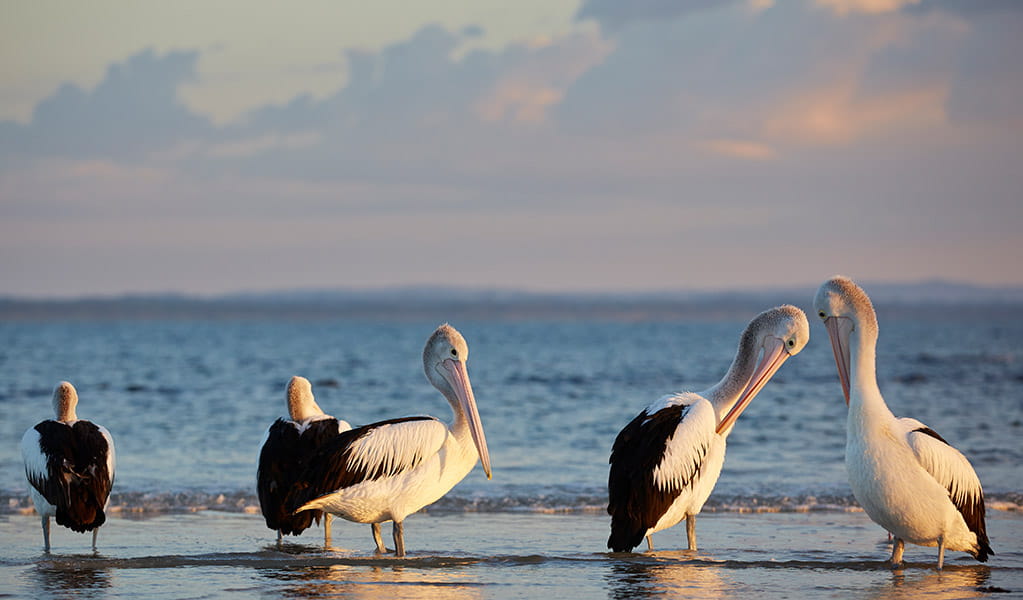
Australian pelican (Pelecanus conspicillatus)
The curious pelican is Australia’s largest flying bird and has the longest bill of any bird in the world. These Australian birds are found throughout Australian waterways and the pelican uses its throat pouch to trawl for fish. Pelicans breed all year round, congregating in large colonies on secluded beaches and islands.
-
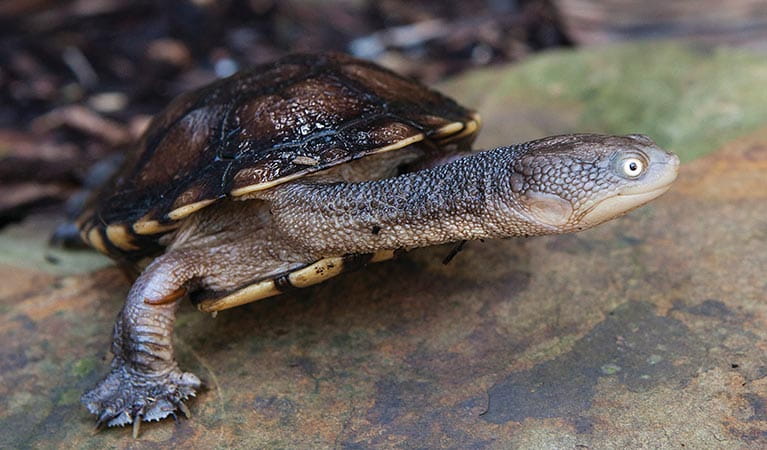
Eastern snake-necked turtle (Chelodina longicollis)
Found across most of NSW, the eastern snake-necked turtle, also known as the eastern long-necked turtle, can be found in swamps, lakes and inland waterways. This freshwater turtle is carnivorous and lives most of its life submerged on the water’s edge, searching for worms and snails.
-
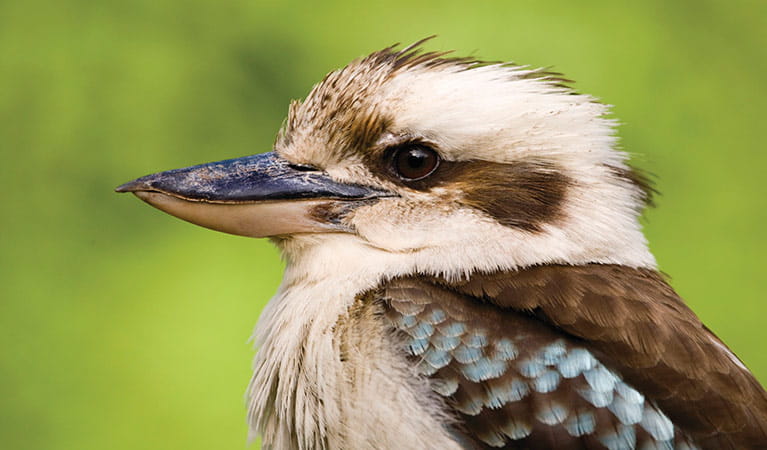
Kookaburra (Dacelo novaeguineae)
Of the 2 species of kookaburra found in Australia, the laughing kookaburra is the best-known and the largest of the native kingfishers. With its distinctive riotous call, the laughing kookaburra is commonly heard in open woodlands and forests throughout NSW national parks, making these ideal spots for bird watching.
-
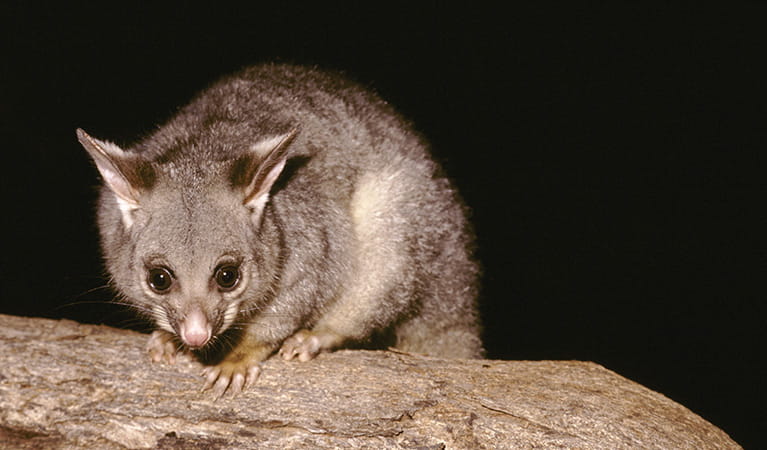
Common brushtail possum (Trichosurus vulpecula)
One of the most widespread of Australian tree-dwelling marsupials, the common brushtail possum is found across most of NSW in woodlands, rainforests and urban areas. With strong claws, a prehensile tail and opposable digits, these native Australian animals are well-adapted for life amongst the trees.
Plants
-
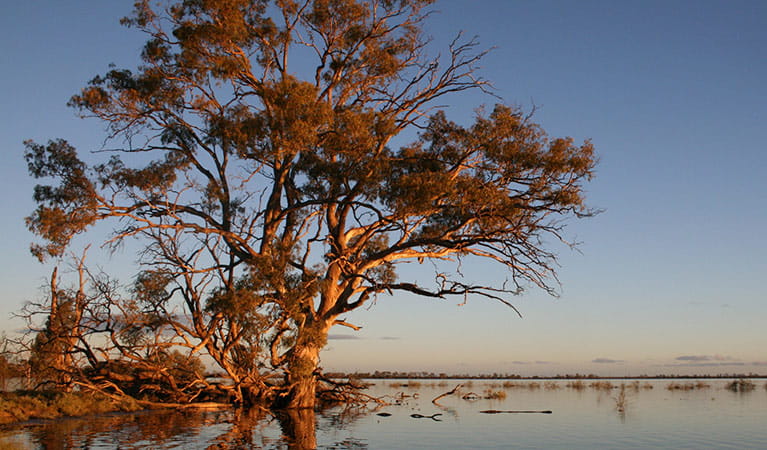
River red gum (Eucalpytus camaldulensis)
Australian native plants, majestic river red gum trees are widespread across Australian inland river systems. The river red gum is a dominant tree species of the Murray-Darling basin which spans NSW, Queensland and Victoria. This iconic native eucalypt grows to a height of 30m and is thought to have a lifespan up to 500-1000 years.

